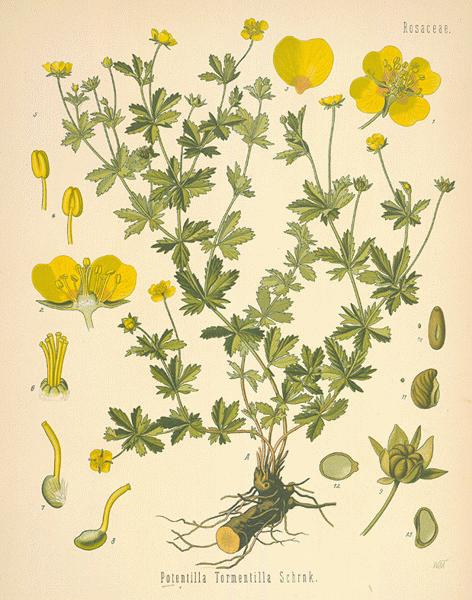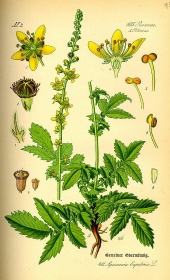Potentilla, more than just a YARFA
https://southernappalachianherbs.blogspot.com/2021/03/potentilla-more-than-just-yarfa.html

The herb we will explore this week is the often overlooked Potentilla. Overlooked, that is, by modern herbalists. Potentilla has a rich history of use. I can hear the late herbalist Michael Moore stating emphatically, “it is just a YARFA!”, or Yet Another Rose Family Astringent. But, depending on the species used, Potentilla may be extremely astringent! Tormentil, Potential erecta, contains more tannin than oak bark. A least twenty-two varieties of Potentilla are utilized in herbal medicine.
Potentilla or Tormentil has a long history of use in German folk medicine. Saint Hildegard von Bingen, writing in the 1100s, described Tormentil as a cold herb. “Its coldness is good for a healthy person and prevails against fevers which arise from noxious food. Take tormentil and cook it in wine, with a little honey added. Strain it through a cloth, and drink it frequently at night, on an empty stomach, and you will become well.” Fr. Johannes Künzle was a very popular Swiss herbalist in the early 1900s. He stated that Potentilla erecta was his best remedy for diarrhea. Potentilla is also an ingredient in the Swedish Bitters.
Plants for future states:
This plant is considered to be one of the safest native astringents and it is widely used in herbal medicine in the treatment of diarrhoea, dysentery, sore throats etc. The whole plant, and especially the root, is antibiotic, strongly astringent, haemostatic and hypoglycaemic. It is used in the treatment of diarrhoea, dysentery, irritable bowel syndrome, colitis, ulcerative colitis etc. Externally, the plant makes a good styptic for cuts etc., and a strongly made decoction has been recommended as a wash for mouth ulcers, infected gums, piles and inflamed eyes. Extracts are used to treat chapping of the anus and cracked nipples. The plant's effectiveness as a toothache remedy is undeniable and it has also been of benefit in treating bed-wetting by children.
Tormentil was widely used among British herbalists, as well, with Culpepper describing its virtues in his unique way:
This is a gallant herb of the Sun. Tormentil is most excellent to stay all kind of fluxes of blood or humours in man or woman, whether at nose, mouth, or belly. The juice of the herb of the root, or the decoction thereof, taken with some Venice treacle, and the person laid to sweat, expels any venom or poison, or the plague, fever, or other contagious diseases, as pox, measles, &c. for it is an ingredient in all antidotes or counter poisons. Andreas Urlesius is of opinion that the decoction of this root is no less effectual to cure the French pox than Guiacum or China; and it is not unlikely, because it so mightily resists putrefaction. The root taken inwardly is most effectual to help any flux of the belly, stomach, spleen, or blood; and the juice wonderfully opens obstructions of the liver and lungs, and thereby helps the yellow jaundice. The powder or decoction drank, or to sit thereon as a bath, is an assured remedy against abortion, if it proceed from the over flexibility or weakness of the inward retentive faculty; as also a plaster made therewith, and vinegar applied to the reins of the back, doth much help not only this, but also those that cannot hold their water, the powder being taken in the juice of plaintain, and is also commended against the worms in children. It is very powerful in ruptures and burstings, as also for bruises and falls, to be used as well outwardly as inwardly. The root hereof made up with pellitory of Spain and allum, and put into a hollow tooth, not only assuages the pain, but stays the flux of humours which causes it. Tormentil is no less effectual and powerful a remedy against outward wounds, sores and hurts, than for inward, and is therefore a special ingredient to be used in wound drinks, lotions and injections, for foul corrupt rotten sores and ulcers of the mouth, secrets, or other parts of the body. The juice or powder of the root put in ointments, plaisters, and such things that are to be applied to wounds or sores, is very effectual, as the juice of the leaves and the root bruised and applied to the throat or jaws, heals the king's evil, and eases the pain of the sciatica; the same used with a little vinegar, is a special remedy against the running sores of the head or other parts; scabs also, and the itch or any such eruptions in the skin, proceeding of salt and sharp humours. The same is also effectual for the piles or hæmorrhoids, if they be washed or bathed therewith, or with the distilled water of the herb and roots. It is found also helpful to dry up any sharp rheum that distills from the head into the eyes, causing redness, pain, waterings, itching, or the like, if a little prepared tutia, or white amber, be used with the distilled water thereof. And here is enough, only remember the Sun challenges this herb.
Maude Grieves gives Potentilla a fine treatment in her Modern Herbal:
The name Tormentil is said to be derived from the Latin tormentum, which signifies such gripings of the intestines as the herb will serve to relieve, likewise the twinges of toothache.
The plant is very astringent, and has been used in some places for tanning.
It has been official in various Pharmacopoeias and was formerly in the Secondary List of the United States Pharmacopoeia.
It is considered one of the safest and most powerful of our native aromatic astringents, and for its tonic properties has been termed 'English Sarsaparilla.'
All parts of the plant are astringent, especially the red, woody rhizome.
The name Tormentil is said to be derived from the Latin tormentum, which signifies such gripings of the intestines as the herb will serve to relieve, likewise the twinges of toothache.
The plant is very astringent, and has been used in some places for tanning.
It has been official in various Pharmacopoeias and was formerly in the Secondary List of the United States Pharmacopoeia.
It is considered one of the safest and most powerful of our native aromatic astringents, and for its tonic properties has been termed 'English Sarsaparilla.'
All parts of the plant are astringent, especially the red, woody rhizome.
Thornton tells of a poor old man who made wonderful cures of ague, smallpox, whooping cough, etc., from an infusion of this herb and became so celebrated locally that Lord William Russell gave him a piece of ground in which to cultivate it, which he did, keeping it a secret for long.
Obviously, Potentilla is more than just a YARFA…. It is a great YARFA! Although several herbs and trees share the tanic qualities of Potentilla, few are as cheerful in appearance, bringing beauty and color to the garden. Perhaps I will plant some by the oak trees, so when an astringent is needed, it will be close at hand regardless the time of year.
Disclaimer
The information on this site is not intended to diagnose or treat any disease or condition. Nothing on this site has been evaluated or approved by the FDA. I am not a doctor. The US government does not recognize the practice of herbal medicine and their is no governing body regulating herbalists. Therefore, I'm just a guy who studies herbs. I am not offering any advice. I won't even claim that anything I write is accurate or true! I can tell you what herbs have "traditionally been used for." I can tell you my own experience and if I believe an herb helped me. I cannot, nor would I tell you to do the same. If you use any herb I, or anyone else, mentions you are treating yourself. You take full responsibility for your health. Humans are individuals and no two are identical. What works for me may not work for you. You may have an allergy, sensitivity or underlying condition that no one else shares and you don't even know about. Be careful with your health. By continuing to read my blog you agree to be responsible for yourself, do your own research, make your own choices and not to blame me for anything, ever.
https://southernappalachianherbs.blogspot.com/
 3
3



















